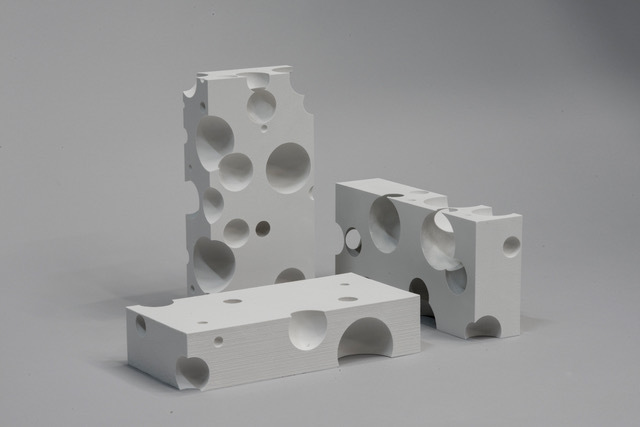Idea
The artistic research and exhibition project was based on the geometric confines of a brick as basic building component of a construction process. We´ve started playing with the idea of 3D prints, which defy the usual expectation of perfection and durability by literally manipulating the DNA of its source material. The initial considerations have led to the idea of intended disintegration by way of introducing an organic substance into the DNA of the printed object. We decided to experiment with visible signs of decomposition and planted fungal spores1 into the structural fabric of the object.
Process
The molecular biologist Bilge Göçen has put us in contact with the Institute of Cancer Research at the University of Vienna, where we had the privilege to work with Prof. Dr. Erich Heidenreich and his colleague Dr. Ferdinand Steinböck, who provided us with professional insights and the necessary resources for our experiments.
For the purpose of breeding fungal spores, the fresh petri dishes filled with agar were left open for two to three hours, before being closed and left untouched for two days. Since the spores are harmful, Bilge Göçen equipped us with pipets, masks, gloves, beakers, and stirring rods, and overlooked the opening of petri dishes with the necessary precaution. Upon opening, the hazardous content was wetted with distilled water and the spores scraped off with a sterile glass rod in order to form a thick grey solution of spores after several hours.
Extended tests started with small samples of plaster, which were printed in various degrees of concentration and distribution of nutrient solution, powder or fungal spores and then matured in dry or humid conditions or soaked with water. It turned out that the plaster itself has to be infiltrated with fungal spores, since those naturally contained in the atmosphere do not seem to provide the necessary propensity of growing on samples saturated with suitable nutrient. The outright infiltration of plaster powder with nutrient and fungal spores was achieved by intermissions of the printing process.
Several options to charge the printing material with the additional components ahead of the printing process had to be discarded for fear of contaminating or potentially blocking the printer nozzle. A plan to convert the machine by adding an additional cartridge and to regulate the mixture and spatial distribution of fungal spores during the printing process could not be realised due to a lack of initial funding. Therefore the plaster bricks were contaminated with an YPD solution (bi-distilled water with lots of powder) and fungal spores throughout the printing process. The design based variation of the bricks porosity (wholes) allowed us to investigate intended variations of decay.
1) The fungus in question belongs primarily to the genus of aspergillus, which contains several hundred species. The biological taxonomy goes as follows: kingdom: fungi, division: ascomycota, class: eurotiomycetes, order: eurotiales, family: trichocomaceae, genus: aspergillus.
